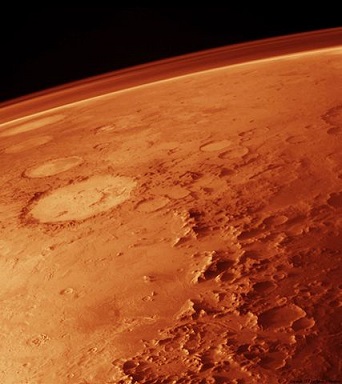Understanding the role of carbon dioxide (CO2) in the Martian atmosphere might provide insights into Earth's own climate dynamics. On Mars, despite an extremely thin atmosphere, the concentration of CO2 is about 15 times that of Earth. One might assume that this would lead to a strong greenhouse effect on the Red Planet, but surprisingly, that's not the case.
 So, why doesn't Mars experience a robust greenhouse effect? The answer lies in the specific wavelengths of energy that CO2 can absorb. Unlike what many believe, CO2 predominantly absorbs energy within a very narrow wavelength window, approximately 15 micrometers. Regardless of how much CO2 is present in the atmosphere, the total amount of heat it can absorb is limited.
So, why doesn't Mars experience a robust greenhouse effect? The answer lies in the specific wavelengths of energy that CO2 can absorb. Unlike what many believe, CO2 predominantly absorbs energy within a very narrow wavelength window, approximately 15 micrometers. Regardless of how much CO2 is present in the atmosphere, the total amount of heat it can absorb is limited.
Now, let's shift our focus to Earth. What truly drives and dominates our greenhouse effect? The answer is water, present in two primary forms: water vapor and clouds. Water contributes significantly, accounting for up to 75% of the greenhouse effect on our planet.
Considering that 70% of Earth's surface is covered by water, one might wonder if we receive an excessive amount of greenhouse effect, causing the planet to overheat. The answer is no, and here's where the magic of atmospheric water comes into play.
You've probably noticed that a sunny day tends to be warmer than a cloudy one during the same season. This is because, during daylight hours, clouds and water vapor act as barriers to sunlight, preventing excess solar radiation from causing the Earth to become excessively hot. It's this natural regulation that keeps our planet within a comfortable temperature range, preventing it from becoming too hot or too cold.
With this everyday knowledge, we can conclude that CO2 isn't the primary contributor to climate change or global warming. In reality, it plays a vital and constructive role in our ecosystem. CO2 is essential for plant life, serving as a key ingredient in photosynthesis, where plants use light energy to convert CO2 and water into organic compounds and oxygen.
While Earth's temperature has risen over the past 150 years, and atmospheric CO2 levels have increased, it's crucial to understand the relationship between these two phenomena. When ocean water warms, even slightly, it releases dissolved CO2 into the atmosphere. This process is akin to the way carbonation in a glass of chilled soda water escapes when it warms up.
So, what is the true driver of climate change? It's essential to acknowledge that the climate has always been subject to change, with various natural factors at play. These include the sun's activity, Earth's orbit, its axial tilt, volcanic activity from thousands and thousands of active volcanoes, both in land and under the oceans, cosmic radiation, and more. While CO2 levels have risen, it's highly improbable that they are the cause of recent climate shifts, as this article has clarified.
.png)
References:
https://marsed.asu.edu/mep/atmosphere
https://www.ces.fau.edu/nasa/module-2/how-greenhouse-effect-works.php
https://ei.lehigh.edu/learners/cc/greenhouse/radiationChart.png
https://co2coalition.org/facts/the-warming-effect-of-each-molecule-of-co2-declines-as-its-concentration-increases/
https://www.noaa.gov/news-release/carbon-dioxide-now-more-than-50-higher-than-pre-industrial-levels
https://www.esa.int/Science_Exploration/Space_Science/Venus_Express/Greenhouse_effects_also_on_other_planets